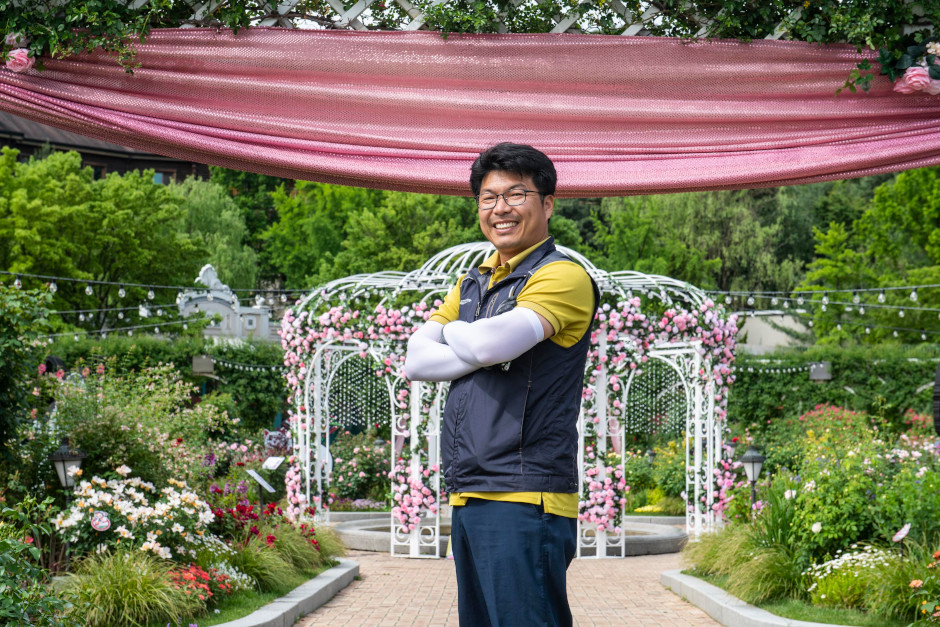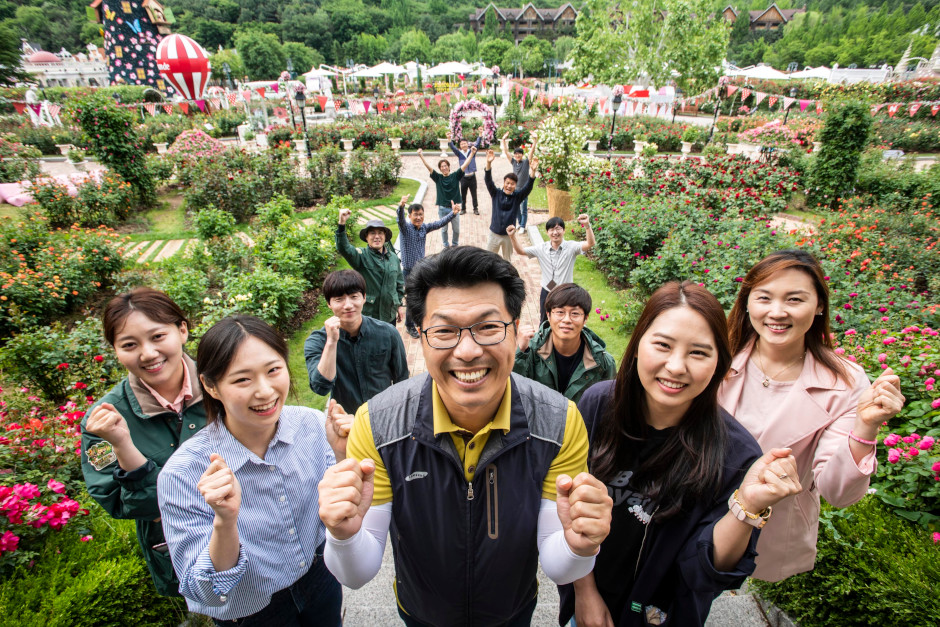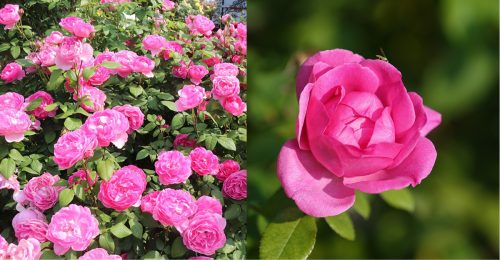Every May and June for the past 35 years, Everland has been busy with its rose festival. When it launched the festival in 1985 it was the country’s first. It practically transformed the concept of flowers from being unapproachable objects of appreciation to something seen, smelled and felt up close in the midst of music and cultural performances. Over the year the festival has seen over 60 million visitors, which means it is entirely possible that every single South Korean has visited the festival at least once. When it started, the festival hosted 150 different kinds of roses, but it has since expanded to 720 different varieties in 2020.
Behind Everland’s spectacular Rose Garden is Ha Ho-soo. He manages the million-flower garden as a Rosarian, a rose expert. But not only does he manage the garden – he also strives to develop new kinds of roses at Everland’s Plant Contents Group.
Pursuing new varieties of beauty
Ha joined Everland in 2003 after finishing studying horticulture, and his relationship with roses started 10 years later. He says, “At that time, a new team was organized to develop our new rose varieties to match the long history of the Rose Festival.” Another goal of the team was to improve the staying power of a rose’s scent for afternoon visitors, as roses give off the strongest scent in the morning and fade throughout the day.
Creating a new rose requires intercrossing, he explains. “First of all, we remove the petals artificially before the flower fully blooms and then separate the stamens into a petri dish and record them. After drying them for two to three hours in shade we can get pollen. Since the flower is left with only the pistils, we wrap them in a plastic bag to prevent more pollen from touching them. Then if you artificially pollinate other varieties within a day or two while the stickiness remains, you will have a new variety.”
But since not every pollinated seed sprouts, it is necessary to increase the probability of a new variety through many attempts. “Ten pollinations generate about 100 seeds as one fruit produces 10 seeds. But usually only 20 to 30% of them germinate. Again, we check for ones with the desired characteristics among the 20-30% and wait for the flowers to bloom for about two more months. When they finally bloom, through screening work we sort out the ones that meet expectations and others that are unexpectedly good. We may not be able to identify the exact characteristics of the variety during their first year since they are so young, so we fully cultivate each one for two to three years.”
Now he is a developer of over 20 new roses, but he had to pick up all these skills when he first started the job. “I learned from institutions of the national government and local governments that cut roses for bouquets. I thought garden rose breeding would be possible using the same process. I could gradually acquire the skills by doing the legwork dozens of times and imitating the hand movements of those who taught me, and also by asking questions thoroughly at every phase in order to learn every stage of intercrossing.”
Patience is necessary to see results
Developing a new variety of rose is the result of patience and waiting. It is not possible to check the results of the work immediately and success can only be confirmed after several years. “I felt very nervous when I was waiting for the next spring after seeding for my results. I seeded in the fall of 2013, which was my first year, and it was the continuation of waiting without any news until February of the next year. I was really happy to find the first seed sprouting out of the over 10,000 planted, but I had to turn down the heat of my heart again for two more months while waiting for the flowers to bloom.” In this step-by-step process he developed a new rose variety for which he received his first registration certificate in 2016, two years after it first sprouted.
The roses developed through this procedure started going public in 2015 at Everland, the 30th anniversary of the first Rose Festival. They include the varieties Rosy Bride, Perfume Everscape, Carnival Everscape, Tealight, Baronne Lily, Tete de Belle and Sweet Dress. Baronne Lily, actually, is named after the first president of the World Federation of Rose Societies. Everland’s new roses have longer-lasting scents and strong resistance to insects. Tete de Belle, notably, has petals that look like laughter and a cool and sweet scent to go with them, while Sweet Dress has a sweet fruity scent.
Since Everland first applied for registration of five new rose varieties with the Korea Seed & Variety Service in 2014, the park registers three to five new kinds every year. As of 2019, there are 16 varieties newly registered and the number is expected to increase to 20 this year.
“We can get exclusive rights for new varieties when they are developed,” Ha says. “In the case of imported roses, we can only grow as many as the number of trees we have bought and increasing that number is prohibited. If you buy 100, you should only grow that many. But in the case of our new varieties, we can multiply them as much as we want.” This is the secret of the abundant Everland Rose Garden that boasts three million roses.
Worthwhile patient pursuit
Of course there have been tough times, but Ha always feels that it is worthwhile. Running the experience program to intercross roses for the Everland Junior Plants Lovers Club, he says, “When I see the kids make their own roses, I think this is an amazing job where I can make something that has not ever existed before by my own hands.”
For Ha, this “amazing job” is not limited only to roses. “I want to also make various products by utilizing the scents of roses. Cooperating with manufacturing companies, I’m trying to make perfumes, diffusers, cosmetics, and syrups that contain Everland’s roses, and I want to make more new rose-related products.”










